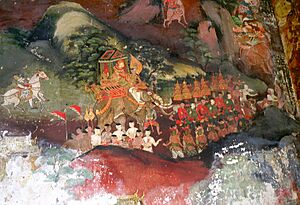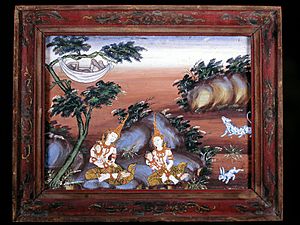Vessantara Jātaka facts for kids

The Vessantara Jātaka is one of the most famous stories in Theravada Buddhism. It's a Jātaka tale, which means it tells about one of Gautama Buddha's past lives. This story is about a kind prince named Vessantara. He was so generous that he gave away everything he owned, even his own children. This showed his perfect virtue of generosity. People also call this story the Great Birth Sermon.
The tale of Prince Vessantara is celebrated every year as a festival. This happens in countries like Thailand, Laos, Myanmar, Sri Lanka, and Cambodia.
Contents
The Story of Prince Vessantara
The Vessantara story is told in slightly different ways across Asia. For example, in Tibet, it's called the Jīnaputra Arthasiddhi Sūtra. The prince there is known as Arthasiddhi. In China, it's the Taizi Xudanuo Jing, and the prince is Sudana. In Japan, he is called Shudaina-taishi.
When Gautama Buddha first visited his father's kingdom after becoming enlightened, some older relatives didn't show him respect. They thought they were too old to bow to him. The Buddha then appeared in the air above them. His father was the first to bow, saying it was time to respect his son. Other family members then bowed and accepted his teachings. Suddenly, rain clouds appeared, and red drops of rain fell. This miracle made his followers ask, "What is this rain?" The Buddha explained that this rain had appeared once before, in his past life. Then, he told them the story of his life as King Vessantara.
Prince Vessantara's Early Life
Prince Vessantara was the son of King Sañjaya of the Sivi Kingdom. He was born in the capital city of Jatuttara. In Buddhist tradition, he is seen as a bodhisatta. This means he was a Buddha-to-be.
His mother, a princess, had done many good deeds in her past life. She wished to be the mother of the next Buddha. After she died, she went to heaven. There, she became a companion of the deva named Sakka or Indra. She lived happily until it was time for her to be reborn as a human. Indra gave her ten wishes. One of her wishes was to become the mother of the bodhisattva who would become enlightened. She was then born into a royal family and later married King Sañjaya.
On the last day of her pregnancy, the Queen wanted to see the capital city. Her husband agreed. She visited many areas, and people were happy to see her. While she was in the merchant area, she gave birth right there in the city's market. Because of this, the new prince was named Vessantara. This name means 'Born in the merchant quarter'. As soon as he opened his eyes, the baby prince asked his mother for money to give to the poor. On the same day, a female elephant brought her pure white baby calf to the palace.
Vessantara grew up to be a very kind person. He loved to give his things away to others. His parents were very proud of him. They supported his charity with their own treasures. Vessantara later married Princess Madri. They had two children, Prince Jali and Princess Kanhajina. Eventually, King Sañjaya retired, and Vessantara became the new King.
Vessantara's Exile and Hermit Life
One day, Vessantara gave away a special white elephant. This elephant could bring rain to his kingdom. He gave it to people from Kalinga, a nearby country that was suffering from a drought. The people of Vessantara's kingdom were very upset. They feared a drought because the elephant was gone. So, they convinced King Sañjaya to take back control and send Vessantara away.
Vessantara willingly gave his kingdom back to his father. Before leaving the city, he also gave away all his wealth. He planned to live in the forest as a rishi (hermit) with his wife Madri and their two children, Jali and Kanha.
A loyal helper suggested they live at Vamka Mountain. They left the city in a chariot pulled by four horses. Along the way, Vessantara gave away his horses. Four gods appeared as deer to pull the chariot instead. Then he gave away his chariot too. The family walked through a forest. The young prince and princess saw fruit on high branches. Their parents couldn't reach it. But, like magic, all the trees bent their branches down for them.
The family arrived at the nearby kingdom of Ceta. The King of Ceta heard they were there and rushed to greet them. He was moved by their story and offered Vessantara his throne. But the prince refused. They also didn't want to stay in a palace. They decided to live simple lives on Vamka Mountain. The King of Ceta ordered a hunter to guard the mountain entrance. This was to make sure no one bothered the family.
Meanwhile, there was a greedy old brahmin named Jujaka. He was a beggar and had a very young, beautiful, and hard-working wife named Amittada. During a drought, Amittada regularly brought water from the well for her old husband. The other women in the village praised her as a good wife. One day, out of jealousy, the village women gathered at the well. They beat up the brahmin's young wife and tore her clothes.

After that day, Amittada refused to go to the well. She told Jujaka to find her some servants so she wouldn't be made fun of anymore. She kept bothering him until he agreed.
Jujaka met a forester guarding Vamka Mountain. He tricked the forester by saying Vessantara's exile was over. He also tricked a hermit. Finally, the brahmin Jujaka found Prince Vessantara in the forest while Madri was away. He asked Vessantara for his two children. Vessantara readily gave them away. Jali and Kanha hid in a lotus pond. Their father found them and asked if they would help him reach his highest goal: becoming a Buddha in a future life. Both children agreed and became Jujaka's servants. Vessantara told the brahmin to take the children to their grandfather. He said, "The king will reward you for bringing his beloved grandchildren back." Jujaka disagreed, saying King Sañjaya would punish him instead. The brahmin tied both children with vines and dragged them like animals. Both children begged their father for help. The old man scolded and hit them with his stick. Vessantara felt angry and reached for his weapon. But he controlled his anger and let his children be taken away.
Madri's path back to their home was blocked by tigers. These were actually gods in disguise. When she didn't see her children, she searched for them all night. She finally collapsed in front of her husband. Vessantara thought she was dead and cried for her. He put her head on his lap and realized she was still breathing. He revived Madri with water. She woke up and immediately kept her distance, as was proper for her vow of simple living. Vessantara told her what had happened. After Madri learned that her husband gave away their children, she praised him for his great act.
The god Śakra worried that Vessantara would give away his wife too. So, he appeared in disguise and asked for Madri. Vessantara readily gave her to him. Then Indra gave Madri back to Vessantara as a trust. This showed that all of Vessantara's acts of kindness and generosity had been perfect.
The Royal Family Returns Home
Two gods felt sorry for the young prince and princess. They pretended to be their parents and helped care for Jali and Kanha. They made Jujaka take a wrong turn. This led him into the Sivi Kingdom and right through the palace gate. King Sañjaya saw the two familiar faces. He ordered his guards to bring them to him. He recognized his grandchildren and paid Jujaka for them. Kanha's price was higher than her brother's. Her father wanted no one else to be able to buy her from Jujaka. In fact, both Jali and Kanha's prices were so high that only King Sañjaya could have paid them.
Jujaka became very rich. At his first meal as a rich man, he ate too much. His stomach couldn't handle it, and he died right there. King Sañjaya sent his men to find Jujaka's family to take his wealth. However, his wife and her family were afraid of being punished for Jujaka's actions, so they ran away.
King Sañjaya planned a big parade to meet his son and daughter-in-law. The Kingdom of Kalinga also returned the white elephant. Kalinga was now rich again. This made the people of Sivi less angry. Jali led the army and people to his parents' home. The family was finally together again. After this very happy moment, all six of them fainted.
Red rain then poured down from Heaven to revive the family. This rain "soaked those who wanted to be soaked, but didn't fall on those who wanted to stay dry." Vessantara was crowned king again and returned to his kingdom. Indra blessed the Sivi Kingdom with a rain of gems. Vessantara let people keep these gems for themselves. The rest went into the kingdom's treasury, which he used for his charity. His treasure never ran out.
The Buddha explained that each person in the story had been reborn as someone around him. Vessantara's parents were reborn as the Buddha's parents. Madri was reborn as the Buddha's former wife. Jali became Rahula, the Buddha's son. Kanha became Upalavanna, the bhikkhuni (nun). The loyal helper who told Vessantara where to live became Ananda, the Buddha's cousin and attendant. Jujaka became Devadatta, the Buddha's enemy. The white elephant became Maha Kassapa.
Vessantara in Culture and Art
Quick facts for kids Vessantara Festival |
|
|---|---|
| Also called | Boun Pha Vet (in Laos) Medin Full Moon Poya (in Sri Lanka) Thet Mahachat (in Thailand) |
| Observed by | Thais, Lao, Sri Lankans, Cambodians and Burmese |
| Type | Buddhist |
| Significance | Commemorates the Vessantara Jataka |
| Date | Full moon day of the 12th lunar month |
The Vessantara Jataka is celebrated in temples during a Buddhist festival. In Central Thailand, it's called Thet Mahachat, meaning "Great Birth". In Laos, it's Boun Pha Vet. In Isan, it's Bun Phawet or Bun Duan Sii ('Merit-making of the fourth month'). It's also an important celebration in Cambodia, Burma, and Sri Lanka.
In Sri Lanka, people often read sad verses from the Vessantara Kāvya at a relative's funeral. These verses are about Madri mourning the loss of her children.
The Thet Mahachat festival is very popular in both rural and city areas. It often includes dance and drama shows, as well as festive parades. During this Buddhist festival, monks give a sermon about the entire Vessantara Jataka story. This is joined by rituals and cultural performances. Because it's so central to these celebrations, the Vessantara Jataka is a big part of traditional stories in many parts of Southeast Asia. Some parts of the story, like the funny pair of Jujaka, the old brahmin, and his young wife Amittada, are very popular during the festival. While it's less important in some places now, in others, it has become even more popular.
Scenes from the Vessantara Jataka are shown on the walls of Buddhist temples all over Southeast Asia. They are also carved into the murals of Angkor Wat in Cambodia. You can also find them in old patterns on ikat silk cloth.
Images for kids
Gallery photos of the murals from Three Bridges Temple (Thai: วัดสะพานสาม wat saphan saam), Phitsanulok, Thailand, 2015.














